Although many students today claim to hate history, it often isn’t history they dislike so much as how history is taught or what they know about historical events. If social studies and history courses consist merely of memorizing dry facts or dates or marching inexorably year after year from the “discovery” of America by the white man to the Civil War or WWI and WWII without discussing the individuals behind those important events, dates, and movements, then there is no wonder that today’s generation avoids history like the proverbial plague. But there are plenty of fantastic books being published today that offer different perspectives on history. In this week’s reviews, the members of the International Reading Association Children’s Literature and Reading Special Interest Group provide some recent titles that may awaken the curiosity in young readers or rekindle an interest in history.
GRADES K-3
Kay, Verla. (2012). Civil War drummer boy. Illus. by Larry Day. New York: G.P. Putnam’s Sons.
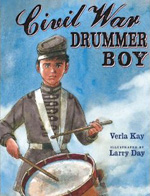 It is April 21, 1861, and the Civil War has begun. The battles don’t involve only teens and adults but even some children. Through the eyes of an enlisted young drummer boy, the author tackles a complex topic and uses short verse to portray the battle scenes and emotions of the War Between the States. The pen-and-ink watercolors shift from bright colors in the opening scenes and those when Johnny is training with the soldiers and all seems cheerful and confident. As the battles grow in intensity, smoke-filled pictures and often blood-smeared scenes bring the war to life and darken the scenes portrayed. An older, taller, and war-weary Johnny returns to the family farm at the end of the book. Teachers may find this book useful as a read aloud or an example of rhymed verse to tell an emotionally charged story. The title could serve as a read aloud introduction to the Civil War or as a picture book companion to Jim Murphy’s The Boys’ War: Confederate and Union Soldiers Talk about the Civil War (Clarion, 1990). Teachers might find it helpful to view a short, artfully done book trailer at Vimeo.
It is April 21, 1861, and the Civil War has begun. The battles don’t involve only teens and adults but even some children. Through the eyes of an enlisted young drummer boy, the author tackles a complex topic and uses short verse to portray the battle scenes and emotions of the War Between the States. The pen-and-ink watercolors shift from bright colors in the opening scenes and those when Johnny is training with the soldiers and all seems cheerful and confident. As the battles grow in intensity, smoke-filled pictures and often blood-smeared scenes bring the war to life and darken the scenes portrayed. An older, taller, and war-weary Johnny returns to the family farm at the end of the book. Teachers may find this book useful as a read aloud or an example of rhymed verse to tell an emotionally charged story. The title could serve as a read aloud introduction to the Civil War or as a picture book companion to Jim Murphy’s The Boys’ War: Confederate and Union Soldiers Talk about the Civil War (Clarion, 1990). Teachers might find it helpful to view a short, artfully done book trailer at Vimeo.
- Karen Hildebrand, Ohio Library and Reading Consultant
GRADES 4-5
Freedman, Russell. (2012). The Boston Tea Party. Illus. by Peter Malone. New York: Holiday House.
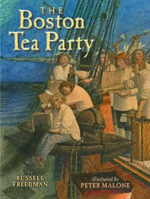 A large crowd stood on Griffin’s Wharf on the night of November 28, 1773. They watched as local colonials, dressed as Mohawk Indians, raided the British merchant ship, the Dartmouth, and dumped its cargo consisting of thousands of pounds of tea into Boston Harbor. The tea was being heavily taxed against the new American colonies, and the angry colonials vehemently decided to protest. Smearing their faces with lampblack, soot, and grease, community members consisting of printers, shipwrights, carpenters, blacksmiths, and even apprentices joined the angry mob. This action became known as the Boston Tea Party, marking the beginnings of active protests that would eventually lead to the American Revolutionary War. Through his usual well-researched and documented narrative, Freedman brings this exciting moment in American history alive for young readers. The watercolor illustrations authentically portray the period in great detail, including the facial expressions of participants and onlookers. The use of actual quotes from many of the “Mohawks” make the night’s activities all that more real. Back matter includes an afterword, a bibliography, and a timeline to add further background information about this era. Used as a read aloud, this book vividly replicates the exciting heat of the moment surrounding an act of defiance from oppressed colonials, on their way to becoming Americans. Teachers might like to show students the exhibit and videos found at the Boston Museum website on the Boston Tea Party.
A large crowd stood on Griffin’s Wharf on the night of November 28, 1773. They watched as local colonials, dressed as Mohawk Indians, raided the British merchant ship, the Dartmouth, and dumped its cargo consisting of thousands of pounds of tea into Boston Harbor. The tea was being heavily taxed against the new American colonies, and the angry colonials vehemently decided to protest. Smearing their faces with lampblack, soot, and grease, community members consisting of printers, shipwrights, carpenters, blacksmiths, and even apprentices joined the angry mob. This action became known as the Boston Tea Party, marking the beginnings of active protests that would eventually lead to the American Revolutionary War. Through his usual well-researched and documented narrative, Freedman brings this exciting moment in American history alive for young readers. The watercolor illustrations authentically portray the period in great detail, including the facial expressions of participants and onlookers. The use of actual quotes from many of the “Mohawks” make the night’s activities all that more real. Back matter includes an afterword, a bibliography, and a timeline to add further background information about this era. Used as a read aloud, this book vividly replicates the exciting heat of the moment surrounding an act of defiance from oppressed colonials, on their way to becoming Americans. Teachers might like to show students the exhibit and videos found at the Boston Museum website on the Boston Tea Party.
- Karen Hildebrand, Ohio Library and Reading Consultant
Ochiltree, Dianne. (2012). Molly, by golly! The legend of Molly Williams, America’s first female firefighter. Illus. by Kathleen Kemly. Honesdale, PA: Boyds Mills Press/ Calkins Creek.
 The Oceanus Engine Company No. 11, part of New York City’s Fire Department in the early 1800’s, was stricken by an influenza outbreak among the firemen. When a fire started on a cold and blizzard-like day, most of the firemen were too sick to battle the blaze. Molly Williams, the African-American cook for Mr. Aymar, one of the volunteer firemen, realized how desperate the situation was and took matters into her own competent hands. She sent young boys known as alert runners into the neighborhoods to warn people about the fire. She also put on a helmet and work gloves and stood beside the available men to pump water from the river. The vivid illustrations portray the heat from the fire juxtaposed against the snowy blizzard as well as the period detail in clothes and buildings and fire equipment. This little-known story shows Molly’s great courage as well as a providing a piece of American history portraying a real hero. Teachers may want to read more of about Molly at the author’s website.
The Oceanus Engine Company No. 11, part of New York City’s Fire Department in the early 1800’s, was stricken by an influenza outbreak among the firemen. When a fire started on a cold and blizzard-like day, most of the firemen were too sick to battle the blaze. Molly Williams, the African-American cook for Mr. Aymar, one of the volunteer firemen, realized how desperate the situation was and took matters into her own competent hands. She sent young boys known as alert runners into the neighborhoods to warn people about the fire. She also put on a helmet and work gloves and stood beside the available men to pump water from the river. The vivid illustrations portray the heat from the fire juxtaposed against the snowy blizzard as well as the period detail in clothes and buildings and fire equipment. This little-known story shows Molly’s great courage as well as a providing a piece of American history portraying a real hero. Teachers may want to read more of about Molly at the author’s website.
- Karen Hildebrand, Ohio Library and Reading Consultant
Ray, Deborah Kogan. (2012). Paiute princess: The story of Sarah Winnemucca. New York: Farrar Straus Giroux/ Frances Foster Books.
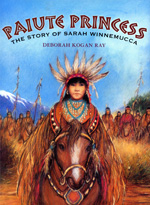 Born in 1844 in Nevada Territory, Paiute Sarah Winnemucca started her life on the edge of two cultures. Chief Truckee recognized his granddaughter’s intelligence and aptitude for learning languages and made sure that she learned English and was educated about the white man’s ways. Her early life in the tribe exposed her to the injustices that were befalling her native peoples due to the influx of settlers, ranchers, miners, the railroad, and other imposing aspects of the white culture. As Sarah grew up and witnessed atrocities by the whites, the chalk and mixed-media illustrations subtly portray these acts of violence. Years later, Sarah chose to be a spokesperson and activist for her tribe, making the world aware of the plight of Native Americans at the hands of the often-unjust and deceitful Bureau of Indian Affairs. She spent her life traveling and speaking to raise awareness, prompting white journalists to tag her with the title of “Princess Sarah.” In 1885 she founded the Peabody School for young Indian children in Lovelock, Nevada before her death in 1891. The author uses actual quotations from Sarah’s autobiography, which was the first book written by a Native American woman in the English language. Ray discusses her book in an interview at Kid Lit Celebrates.
Born in 1844 in Nevada Territory, Paiute Sarah Winnemucca started her life on the edge of two cultures. Chief Truckee recognized his granddaughter’s intelligence and aptitude for learning languages and made sure that she learned English and was educated about the white man’s ways. Her early life in the tribe exposed her to the injustices that were befalling her native peoples due to the influx of settlers, ranchers, miners, the railroad, and other imposing aspects of the white culture. As Sarah grew up and witnessed atrocities by the whites, the chalk and mixed-media illustrations subtly portray these acts of violence. Years later, Sarah chose to be a spokesperson and activist for her tribe, making the world aware of the plight of Native Americans at the hands of the often-unjust and deceitful Bureau of Indian Affairs. She spent her life traveling and speaking to raise awareness, prompting white journalists to tag her with the title of “Princess Sarah.” In 1885 she founded the Peabody School for young Indian children in Lovelock, Nevada before her death in 1891. The author uses actual quotations from Sarah’s autobiography, which was the first book written by a Native American woman in the English language. Ray discusses her book in an interview at Kid Lit Celebrates.
- Karen Hildebrand, Ohio Library and Reading Consultant
Rubin, Susan Goldman. (2012). Jean Laffite: The pirate who saved America. Illus. by Jeff Himmelman. New York: Abrams.
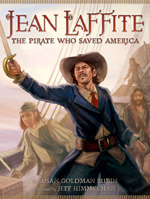 This biography will appeal to all adventure-seekers. Jean Laffite, along with his brothers, was a pirate who seized and robbed Spanish ships. His family was kicked out of Spain because they were Jewish. Consequently, they detested Spain and captured every ship in the Gulf of Mexico owned by Spain. During these watery conflicts, they won duels, took sailors as prisoners and gained cargo such as gold, coffee and cinnamon. Even though Jean was a pirate he was known to be polite, calm and wise in manner. He even helped other pirates settle quarrels and later became known as the “boss.” During the War of 1812, when the British wanted to reclaim America, the British Royal Navy tried to persuade Jean to help them beat the Americans. But Jean, along with the Baratarians (other pirates in Louisiana), defended their country by killing 2,500 British soldiers within 30 minutes, refusing to allow the British to invade New Orleans. President James Madison praised the pirates’ courage and loyal service by granting them citizenship. More information about Laffite is shared in an author’s note, bibliography, and places to visit.
This biography will appeal to all adventure-seekers. Jean Laffite, along with his brothers, was a pirate who seized and robbed Spanish ships. His family was kicked out of Spain because they were Jewish. Consequently, they detested Spain and captured every ship in the Gulf of Mexico owned by Spain. During these watery conflicts, they won duels, took sailors as prisoners and gained cargo such as gold, coffee and cinnamon. Even though Jean was a pirate he was known to be polite, calm and wise in manner. He even helped other pirates settle quarrels and later became known as the “boss.” During the War of 1812, when the British wanted to reclaim America, the British Royal Navy tried to persuade Jean to help them beat the Americans. But Jean, along with the Baratarians (other pirates in Louisiana), defended their country by killing 2,500 British soldiers within 30 minutes, refusing to allow the British to invade New Orleans. President James Madison praised the pirates’ courage and loyal service by granting them citizenship. More information about Laffite is shared in an author’s note, bibliography, and places to visit.
- Deanna Day, Washington State University Vancouver
Stout, Glenn. (2012). Good Sports: Able to Play. New York: Houghton Mifflin Harcourt.
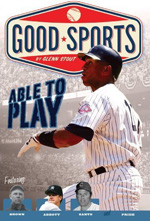 Sports history showcases athletes who overcame physical disabilities. This slim volume features four baseball players who played the game despite their physical challenges. After losing three fingers in a farming accident, Mordecai (Three Finger) Brown went on to become a professional baseball pitcher. When he was 24 he learned to pitch a curve ball with three stumps and two crooked fingers to hold the ball. After playing for the St. Louis Cardinals, the Chicago Cubs, and the Cincinnati Reds, he was elected to the National Baseball Hall of Fame in 1949. In 1958, 18-year old Ron Santo graduated as the top athlete in the history of Washington State. He chose to play for the Chicago Cubs, even if they couldn’t offer him as much money as other teams. A routine blood test revealed that Ron had type I diabetes. At that time, the life expectancy for someone diagnosed with diabetes was only 25 years. Ron learned how to play baseball while dealing with the disease. Twelve years later, his fans and teammates came together to collect funds for diabetes research by hosting “Ron Santo Day.” Jim Abbott was born without a right hand. His right hand was a stump just below his elbow with only one small, misshapen finger. Although his parents encouraged him to try a prosthetic arm, Jim was happy to do everything with one hand. Jim loved the Detroit Tigers. Despite being called cruel names such as “crab” by the youngsters in his native Florida, Jim ignored their taunts and eventually became proficient enough to play professional baseball for 10 years before retiring. Curtis Pride was born deaf. He excelled in sports, including track, basketball, and soccer. The New York Mets drafted Curtis for their baseball team while he was still in high school. Because he also had a basketball scholarship, he played baseball in the summer and studied finance and played basketball the rest of the year. After his graduation, he was drafted by the Montreal Expos to play professional baseball where he played for several teams. The inspiring stories of these four men make this a great volume for reluctant readers and baseball lovers everywhere.
Sports history showcases athletes who overcame physical disabilities. This slim volume features four baseball players who played the game despite their physical challenges. After losing three fingers in a farming accident, Mordecai (Three Finger) Brown went on to become a professional baseball pitcher. When he was 24 he learned to pitch a curve ball with three stumps and two crooked fingers to hold the ball. After playing for the St. Louis Cardinals, the Chicago Cubs, and the Cincinnati Reds, he was elected to the National Baseball Hall of Fame in 1949. In 1958, 18-year old Ron Santo graduated as the top athlete in the history of Washington State. He chose to play for the Chicago Cubs, even if they couldn’t offer him as much money as other teams. A routine blood test revealed that Ron had type I diabetes. At that time, the life expectancy for someone diagnosed with diabetes was only 25 years. Ron learned how to play baseball while dealing with the disease. Twelve years later, his fans and teammates came together to collect funds for diabetes research by hosting “Ron Santo Day.” Jim Abbott was born without a right hand. His right hand was a stump just below his elbow with only one small, misshapen finger. Although his parents encouraged him to try a prosthetic arm, Jim was happy to do everything with one hand. Jim loved the Detroit Tigers. Despite being called cruel names such as “crab” by the youngsters in his native Florida, Jim ignored their taunts and eventually became proficient enough to play professional baseball for 10 years before retiring. Curtis Pride was born deaf. He excelled in sports, including track, basketball, and soccer. The New York Mets drafted Curtis for their baseball team while he was still in high school. Because he also had a basketball scholarship, he played baseball in the summer and studied finance and played basketball the rest of the year. After his graduation, he was drafted by the Montreal Expos to play professional baseball where he played for several teams. The inspiring stories of these four men make this a great volume for reluctant readers and baseball lovers everywhere.
- Rani Iyer, Washington State University Pullman
GRADES 6-8
Bradley, Kimberly Brubaker. (2011). Jefferson’s sons. New York: Dial.
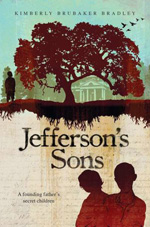 Well-researched historical fiction often has large kid-appeal, and the fact that this story revolves around one of the nation's founding fathers makes it even more compelling. Readers will be troubled by the distance, dissonance, and dishonesty between Thomas Jefferson's written words about freedom and mankind’s inalienable rights in the Declaration of Independence, and his own actions in owning slaves on his Monticello plantation, hiding his relationship with Sally Hemings, and never acknowledging publicly their four children. The children, Beverly, Harriet, Maddie, and Eston, stayed in the slave quarters, their existence an open secret not shared with the outside world or even the rest of Jefferson's family. The story is told from the perspectives of Beverly and Maddie, and then from Peter, a friend of the Hemings family. While their mother, who was one-eighth black, made sure that the children would be freed when they turned 21, their ability to pass for white in the world outside the plantation depended on the lightness or darkness of their skins. Thus, not all of the children would be able to have the same freedoms once they were grown. Complicated and troubling on many levels, the book covers the last 20 years of Jefferson's life. While there is certainly affection between Thomas and Sallie, he didn’t free her while he was alive, and they never lived openly as a couple. Clearly, Jefferson was a product of his times, and acted accordingly, but readers will wonder at his inattention to these four children and his cavalier treatment of the human beings who kept his plantation running. Curious readers will ponder the difficulty of the lives of Jefferson's grown up children, unable to stay in touch with the family members they left behind on the plantation, carrying the secret of their ancestry to the grave. This book is highly recommended, engrossing reading.
Well-researched historical fiction often has large kid-appeal, and the fact that this story revolves around one of the nation's founding fathers makes it even more compelling. Readers will be troubled by the distance, dissonance, and dishonesty between Thomas Jefferson's written words about freedom and mankind’s inalienable rights in the Declaration of Independence, and his own actions in owning slaves on his Monticello plantation, hiding his relationship with Sally Hemings, and never acknowledging publicly their four children. The children, Beverly, Harriet, Maddie, and Eston, stayed in the slave quarters, their existence an open secret not shared with the outside world or even the rest of Jefferson's family. The story is told from the perspectives of Beverly and Maddie, and then from Peter, a friend of the Hemings family. While their mother, who was one-eighth black, made sure that the children would be freed when they turned 21, their ability to pass for white in the world outside the plantation depended on the lightness or darkness of their skins. Thus, not all of the children would be able to have the same freedoms once they were grown. Complicated and troubling on many levels, the book covers the last 20 years of Jefferson's life. While there is certainly affection between Thomas and Sallie, he didn’t free her while he was alive, and they never lived openly as a couple. Clearly, Jefferson was a product of his times, and acted accordingly, but readers will wonder at his inattention to these four children and his cavalier treatment of the human beings who kept his plantation running. Curious readers will ponder the difficulty of the lives of Jefferson's grown up children, unable to stay in touch with the family members they left behind on the plantation, carrying the secret of their ancestry to the grave. This book is highly recommended, engrossing reading.
- Barbara A. Ward, Washington State University Pullman
McArthur, Debra. (2012). A voice for Kanzas. La Jolla, CA: Kane/Miller.
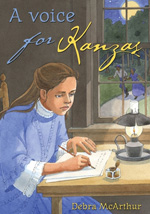 The months leading to the Civil War were filled with turmoil as debate swirled around whether new territories would allow or forbid slavery. This historical fiction title makes that argument even more personal through the eyes of a young girl. To her dismay, thirteen-year-old Lucy Thomkins and her parents head to the Kansas Territory in 1855 in order to support the abolitionist movement and to start a business. A budding poet, Lucy doubts that she will find inspiration for her writing in her new home. As she fends off bullies at school who tease her because of her clothing and attitude, she accidentally learns that some of her neighbors are involved in the abolitionist movement, and she becomes friends with Levi, a Native American boy. Through her experiences, Lucy realizes that writing need not focus only on the world's beauty but may be used to encourage societal change. As Lucy pens anonymous letters to the newspaper editor and crafts poetry dealing with freedom and slavery, she finds her writing voice and an unexpected source for inspiration. Readers will enjoy watching Lucy’s growth amid her new surroundings as she copes with some of the settlers’ less than courteous actions. The author makes clear just how deeply divided about the issue of slavery was the area that would become the state of Kansas.
The months leading to the Civil War were filled with turmoil as debate swirled around whether new territories would allow or forbid slavery. This historical fiction title makes that argument even more personal through the eyes of a young girl. To her dismay, thirteen-year-old Lucy Thomkins and her parents head to the Kansas Territory in 1855 in order to support the abolitionist movement and to start a business. A budding poet, Lucy doubts that she will find inspiration for her writing in her new home. As she fends off bullies at school who tease her because of her clothing and attitude, she accidentally learns that some of her neighbors are involved in the abolitionist movement, and she becomes friends with Levi, a Native American boy. Through her experiences, Lucy realizes that writing need not focus only on the world's beauty but may be used to encourage societal change. As Lucy pens anonymous letters to the newspaper editor and crafts poetry dealing with freedom and slavery, she finds her writing voice and an unexpected source for inspiration. Readers will enjoy watching Lucy’s growth amid her new surroundings as she copes with some of the settlers’ less than courteous actions. The author makes clear just how deeply divided about the issue of slavery was the area that would become the state of Kansas.
- Barbara A. Ward, Washington State University Pullman
McKissack, Patricia C., & McKissack, Jr., Frederick L. (2012). Best shot in the West: The adventures of Nat Love. Illus. by Randy DuBurke. San Francisco: Chronicle Books.
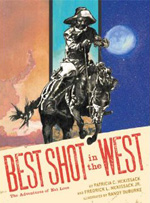 The story of Nat Love, also known as Deadwood Dick, whose facility with a gun was almost legendary, bears some resemblance to an American tall tale due the many coincidences and feats recorded during Love’s life. Readers are sure to relish the story of a most unlikely hero, a man born as a slave in 1854, his subsequent losses and hardships, and then his incredible adventures as a cowboy. Surely, his is a story worth telling just for the gasp-worthy passages that describe how he determinedly broke the most reluctant horses and his near-death during a cattle stampede or an ambush during a cattle drive. Partly biography and partly fiction, this title is certainly engaging and lends itself well to its graphic novel format since Love’s life seems to have been so episodic with great tragedy leavened by moments of triumph. The book begins with Nat having left behind his adventurous life on the range to travel the rails as a porter. Since his current job necessitated having to snap to the orders of those who considered themselves better than him, readers will realize how hard that sort of behavior must have been on the proud Love. How embarrassed those rude passengers might have been if they had realized with whom they were speaking! The acrylic and pen illustrations provide a haunting backdrop to Love’s story, making it almost impossible to distinguish the features of the characters or even the setting while readers are traveling through the misty fog of time and adventures long in the past.
The story of Nat Love, also known as Deadwood Dick, whose facility with a gun was almost legendary, bears some resemblance to an American tall tale due the many coincidences and feats recorded during Love’s life. Readers are sure to relish the story of a most unlikely hero, a man born as a slave in 1854, his subsequent losses and hardships, and then his incredible adventures as a cowboy. Surely, his is a story worth telling just for the gasp-worthy passages that describe how he determinedly broke the most reluctant horses and his near-death during a cattle stampede or an ambush during a cattle drive. Partly biography and partly fiction, this title is certainly engaging and lends itself well to its graphic novel format since Love’s life seems to have been so episodic with great tragedy leavened by moments of triumph. The book begins with Nat having left behind his adventurous life on the range to travel the rails as a porter. Since his current job necessitated having to snap to the orders of those who considered themselves better than him, readers will realize how hard that sort of behavior must have been on the proud Love. How embarrassed those rude passengers might have been if they had realized with whom they were speaking! The acrylic and pen illustrations provide a haunting backdrop to Love’s story, making it almost impossible to distinguish the features of the characters or even the setting while readers are traveling through the misty fog of time and adventures long in the past.
- Barbara A. Ward, Washington State University Pullman
Rappaport, Doreen. (2012). Beyond courage: The untold story of Jewish resistance during the Holocaust. Somerville, MA: Candlewick.
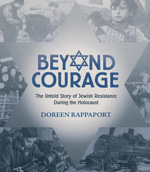 The author shares the inspiring stories she collected during six years of research from those who resisted the Nazis during the Holocaust. In this new collection of stories revealing the courage of those Jews who fought against Hitler and the Nazi regime, the author begins with the events of Kristallnacht and describes the heroism of two teens who remove Torah scrolls from a synagogue. She then moves chronologically to other acts of heroism. She tells about the transport of children to other lands and how children were smuggled out of cities right under the noses of the Nazis. She also details the courage and determination of resistance fighters in the Polish ghettos and in the camps. While some of the stories are brief, hinting at the clear-eyed acts of heroism sure to result in death, others are longer and more detailed. All of the stories, though, are fascinating, inspiring, and humbling, vivid reminders. From the young and from the old, from males and from females, inside the cities and in rural areas, there was organized resistance to Hitler's campaign to eradicate the Jews. Heroism came from the most unlikely of sources; for instance, one sidebar notes how art teacher Friedl Dicker-Brandeis brought art supplies with her when she was transported to Theresienstadt, and then hid the children's drawings when she was moved to Auschwitz. In another section, the author describes how some individuals kept records of what was happening so the world would know the truth, and then placed their accounts in milk cans that were buried later. The book is also filled with photographs so readers may see these very ordinary individuals who behaved so heroically. Lightly shaded photos behind the text hint at the courage and determination behind the Nazis’ atrocities. Readers who want to read more stories of heroism may want to visit the author’s website.
The author shares the inspiring stories she collected during six years of research from those who resisted the Nazis during the Holocaust. In this new collection of stories revealing the courage of those Jews who fought against Hitler and the Nazi regime, the author begins with the events of Kristallnacht and describes the heroism of two teens who remove Torah scrolls from a synagogue. She then moves chronologically to other acts of heroism. She tells about the transport of children to other lands and how children were smuggled out of cities right under the noses of the Nazis. She also details the courage and determination of resistance fighters in the Polish ghettos and in the camps. While some of the stories are brief, hinting at the clear-eyed acts of heroism sure to result in death, others are longer and more detailed. All of the stories, though, are fascinating, inspiring, and humbling, vivid reminders. From the young and from the old, from males and from females, inside the cities and in rural areas, there was organized resistance to Hitler's campaign to eradicate the Jews. Heroism came from the most unlikely of sources; for instance, one sidebar notes how art teacher Friedl Dicker-Brandeis brought art supplies with her when she was transported to Theresienstadt, and then hid the children's drawings when she was moved to Auschwitz. In another section, the author describes how some individuals kept records of what was happening so the world would know the truth, and then placed their accounts in milk cans that were buried later. The book is also filled with photographs so readers may see these very ordinary individuals who behaved so heroically. Lightly shaded photos behind the text hint at the courage and determination behind the Nazis’ atrocities. Readers who want to read more stories of heroism may want to visit the author’s website.
- Barbara A. Ward, Washington State University Pullman
Swain, Gwenyth. (2012). Hope and tears: Ellis Island voices. Honesdale, PA: Boyds Mills Press/Calkins Creek.
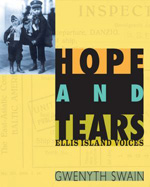 The author has paired period photographs taken at Ellis Island with poems, scripts, and essays that portray the immigrant experience. Although these short texts are fictional, the author has captured the spirit of each photograph in words that will make this an excellent choice for a read aloud or reader’s theater or a compilation of short passages in segments. The book is divided into six chapters: Ellis Islands, Arrivals, Inspections, Island of Hope, Island of Tears, Living and Working, and Closed Doors Reopened. The chapters are arranged chronologically as more and more immigrants arrive in America and are detained at Ellis Island – some for physicals, some to wait for sponsoring relatives or prospective employers. The possibility of being sent back looms over each new entrant. The final chapter takes a contemporary look at immigration today. Readers may want to visit the author’s website for more background on her research on Ellis Island she conducted before writing this book. Teachers can direct students to the Ellis Island Museum website or make use of the curriculum resources at the National Parks Service website.
The author has paired period photographs taken at Ellis Island with poems, scripts, and essays that portray the immigrant experience. Although these short texts are fictional, the author has captured the spirit of each photograph in words that will make this an excellent choice for a read aloud or reader’s theater or a compilation of short passages in segments. The book is divided into six chapters: Ellis Islands, Arrivals, Inspections, Island of Hope, Island of Tears, Living and Working, and Closed Doors Reopened. The chapters are arranged chronologically as more and more immigrants arrive in America and are detained at Ellis Island – some for physicals, some to wait for sponsoring relatives or prospective employers. The possibility of being sent back looms over each new entrant. The final chapter takes a contemporary look at immigration today. Readers may want to visit the author’s website for more background on her research on Ellis Island she conducted before writing this book. Teachers can direct students to the Ellis Island Museum website or make use of the curriculum resources at the National Parks Service website.
- Karen Hildebrand, Ohio Library and Reading Consultant
GRADES 9-12
Aronson, Marc. (2012). Master of deceit: J. Edgar Hoover and America in the age of lies. Somerville, MA: Candlewick.
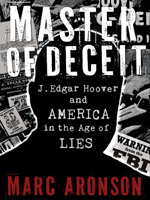 The name of J. Edgar Hoover, the long-time director of the Federal Bureau of Investigation, was long associated with power and fear. This book about his life and times provides insight into a man who became so powerful that he and his agency could get away with keeping secret files, browbeating others, even collecting information on those he feared, disliked, or suspected of harboring Communist sympathies. It begs the question of who polices the agency responsible for protecting the nation and its citizens. The book begins with a letter attempting to blackmail civil rights leader Martin Luther King, Jr. and then briefly covers Hoover's childhood and rise to power. As part of the book’s eighteen chapters, Aronson takes readers through some of the nation’s more unsavory history and periods of paranoia and secrecy that colored the way some Americans regarded others. Among other critical incidents, he revisits Senator Joseph McCarthy's attempts to ferret out Communists in the motion picture industry, the Rosenbergs' trial and execution, and even the torture used to gain information after the fall of the Twin Towers. Clearly, Hoover was a master manipulator and skilled at self-promotion, and the author hypothesizes possible motivations for his actions and his secrets, even addressing rumors about Hoover's sexuality. While sifting through the nation’s past, Aronson also ponders the trade-off between blissful unawareness of potential dangers and the price of secrecy and security. Readers are sure to ponder the fine line between protection and intrusive as well as how information obtained secretly might be used against others. This thoroughly engaging and impeccably researched book brings many figures from history to life again, describing their personalities and character traits. Hoover, for instance, is not painted solely in a negative light but with an attempt to understand the man and his context. Readers will enjoy sifting through the photographs that fill the book's pages and relishing Aronson's description of his own research and writing process. This title is highly recommended, and might even prompt some passionate discussions among parents and their teens.
The name of J. Edgar Hoover, the long-time director of the Federal Bureau of Investigation, was long associated with power and fear. This book about his life and times provides insight into a man who became so powerful that he and his agency could get away with keeping secret files, browbeating others, even collecting information on those he feared, disliked, or suspected of harboring Communist sympathies. It begs the question of who polices the agency responsible for protecting the nation and its citizens. The book begins with a letter attempting to blackmail civil rights leader Martin Luther King, Jr. and then briefly covers Hoover's childhood and rise to power. As part of the book’s eighteen chapters, Aronson takes readers through some of the nation’s more unsavory history and periods of paranoia and secrecy that colored the way some Americans regarded others. Among other critical incidents, he revisits Senator Joseph McCarthy's attempts to ferret out Communists in the motion picture industry, the Rosenbergs' trial and execution, and even the torture used to gain information after the fall of the Twin Towers. Clearly, Hoover was a master manipulator and skilled at self-promotion, and the author hypothesizes possible motivations for his actions and his secrets, even addressing rumors about Hoover's sexuality. While sifting through the nation’s past, Aronson also ponders the trade-off between blissful unawareness of potential dangers and the price of secrecy and security. Readers are sure to ponder the fine line between protection and intrusive as well as how information obtained secretly might be used against others. This thoroughly engaging and impeccably researched book brings many figures from history to life again, describing their personalities and character traits. Hoover, for instance, is not painted solely in a negative light but with an attempt to understand the man and his context. Readers will enjoy sifting through the photographs that fill the book's pages and relishing Aronson's description of his own research and writing process. This title is highly recommended, and might even prompt some passionate discussions among parents and their teens.
- Barbara A. Ward, Washington State University Pullman
Coats, J. Anderson. (2012). The wicked and the just. New York: Harcourt.
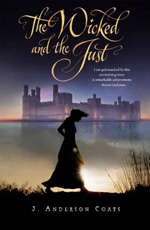 Set in medieval England and Wales in the 1290’s, this story describes how young Cecily’s father has taken the post of burgess in the newly conquered town of Caernarvon in Wales. She is furious at having to leave her comfortable life in England. As she settles into her new surroundings she assumes the position of the woman of the house in charge of the servants. Gwenhwyfar or Gwinny is one of the young Welsh maids serving Cecily in the castle. During her life in Wales, Gwinny has been horribly exploited, and her resentment toward the English, represented by Cecily, is seething. When the castle town is attacked and an unwanted marital match is made for Cecily, it is Gwinny, surprisingly, who is able to help Cecily. At another point in the story, Cecily, unbeknownst to Gwinny, is able to offer aid to Gwinny’s failing mother. The ravages of war and cruelty shown to others are harshly brought to bear in this story as the reader shifts between the voices of Cecily and Gwinny. The author has provided historical notes at the end. Author J. Anderson Coats is part of the Skype an Author Network.
Set in medieval England and Wales in the 1290’s, this story describes how young Cecily’s father has taken the post of burgess in the newly conquered town of Caernarvon in Wales. She is furious at having to leave her comfortable life in England. As she settles into her new surroundings she assumes the position of the woman of the house in charge of the servants. Gwenhwyfar or Gwinny is one of the young Welsh maids serving Cecily in the castle. During her life in Wales, Gwinny has been horribly exploited, and her resentment toward the English, represented by Cecily, is seething. When the castle town is attacked and an unwanted marital match is made for Cecily, it is Gwinny, surprisingly, who is able to help Cecily. At another point in the story, Cecily, unbeknownst to Gwinny, is able to offer aid to Gwinny’s failing mother. The ravages of war and cruelty shown to others are harshly brought to bear in this story as the reader shifts between the voices of Cecily and Gwinny. The author has provided historical notes at the end. Author J. Anderson Coats is part of the Skype an Author Network.
- Karen Hildebrand, Ohio Library and Reading Consultant
Sheinkin, Steve. (2012). Bomb – the race to build-and steal-the world’s most dangerous weapon. New York: Macmillan/ FlashPoint.
 Scientists, political leaders, and spies – everyone wanted the atomic bomb. It was 1938 when the radioactive uranium atom was split. And so began the race to develop the world’s most destructive bomb – a war-ending bomb. Sheinkin’s well-researched background into the history of the atomic bomb deals not only with the scientific aspect but also goes on to reveal the attempts by the Soviets to steal the secret behind the creation of the first atomic bomb for themselves. This book travels the world as the history of the era unfolds from the moment the original German scientist made the atomic discovery and then on to bringing many of those scientists to the United States to work at the University of Chicago, and then continuing to the atomic testing grounds in New Mexico. The book is divided into several parts: the Prologue, Part 1 – Three-Way Race; Part 2 – Chain Reaction; Part 3 – How to Build an Atomic Bomb; Part 4 – Final Assembly; and concludes with an Epilogue, Race to Trinity, and extensive source notes and credits. Photographs are interspersed throughout each chapter to help readers see the many individuals who played a part in this real life drama. Read more about this bomb at the author’s website.
Scientists, political leaders, and spies – everyone wanted the atomic bomb. It was 1938 when the radioactive uranium atom was split. And so began the race to develop the world’s most destructive bomb – a war-ending bomb. Sheinkin’s well-researched background into the history of the atomic bomb deals not only with the scientific aspect but also goes on to reveal the attempts by the Soviets to steal the secret behind the creation of the first atomic bomb for themselves. This book travels the world as the history of the era unfolds from the moment the original German scientist made the atomic discovery and then on to bringing many of those scientists to the United States to work at the University of Chicago, and then continuing to the atomic testing grounds in New Mexico. The book is divided into several parts: the Prologue, Part 1 – Three-Way Race; Part 2 – Chain Reaction; Part 3 – How to Build an Atomic Bomb; Part 4 – Final Assembly; and concludes with an Epilogue, Race to Trinity, and extensive source notes and credits. Photographs are interspersed throughout each chapter to help readers see the many individuals who played a part in this real life drama. Read more about this bomb at the author’s website.
- Karen Hildebrand, Ohio Library and Reading Consultant
Weaver, Lila Quintero. (2012). Darkroom: a memoir in black and white. Birmingham: University of Alabama Press.
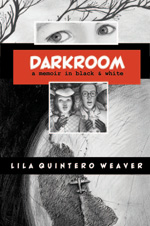 Lila Weaver was five-years-old when she and her family moved to Alabama from Argentina in 1961. She and her family found themselves outsiders, in this era of Jim Crow and distinct separation of black and white. Lila and her family were neither. Using the graphic novel format, she relates this family memoir through black and gray sketches that reflect the photography of her father. Her mother was a visual artist as well, and not surprisingly, the perspective in this book is artistic as well as political. The author describes life in Alabama during a time when civil rights were the main focus in American politics. The fact that her family was actually experiencing a similar yet unique kind of discrimination provides a fresh perspective into this 1960’s scenario. Teachers may want to listen to an NPR discussion of the book.
Lila Weaver was five-years-old when she and her family moved to Alabama from Argentina in 1961. She and her family found themselves outsiders, in this era of Jim Crow and distinct separation of black and white. Lila and her family were neither. Using the graphic novel format, she relates this family memoir through black and gray sketches that reflect the photography of her father. Her mother was a visual artist as well, and not surprisingly, the perspective in this book is artistic as well as political. The author describes life in Alabama during a time when civil rights were the main focus in American politics. The fact that her family was actually experiencing a similar yet unique kind of discrimination provides a fresh perspective into this 1960’s scenario. Teachers may want to listen to an NPR discussion of the book.
- Karen Hildebrand, Ohio Library and Reading Consultant
Wein, Elizabeth. (2012). Code name Verity. New York: Hyperion Books.
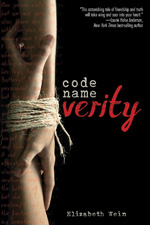 Two young women’s lives become intertwined through the auspices of World War II. As Maggie, the pilot, and Julia, the spy (known as Verity), become friends, readers learn about the girls’ very different backgrounds set against the backdrop of WWII. In a mission flying over France, their plane crashes, and Julia is captured. The Nazis begin their torture to get information from their captive about the British War Effort. Trying to delay her impending death and succumbing to the torture, she begins her tale of the crash and her dear friend Maggie. This harsh, riveting story portrays not only the depth of two girls’ friendship but the courage displayed in both these young women facing the consequences of war. The second part of the book provides the story from Maggie’s point of view. This compelling story about war and friendship will keep readers gasping as they read with tear-filled eyes. Teachers can watch the book trailer and learn more of the back story at the author’s website.
Two young women’s lives become intertwined through the auspices of World War II. As Maggie, the pilot, and Julia, the spy (known as Verity), become friends, readers learn about the girls’ very different backgrounds set against the backdrop of WWII. In a mission flying over France, their plane crashes, and Julia is captured. The Nazis begin their torture to get information from their captive about the British War Effort. Trying to delay her impending death and succumbing to the torture, she begins her tale of the crash and her dear friend Maggie. This harsh, riveting story portrays not only the depth of two girls’ friendship but the courage displayed in both these young women facing the consequences of war. The second part of the book provides the story from Maggie’s point of view. This compelling story about war and friendship will keep readers gasping as they read with tear-filled eyes. Teachers can watch the book trailer and learn more of the back story at the author’s website.
- Karen Hildebrand, Ohio Library and Reading Consultant